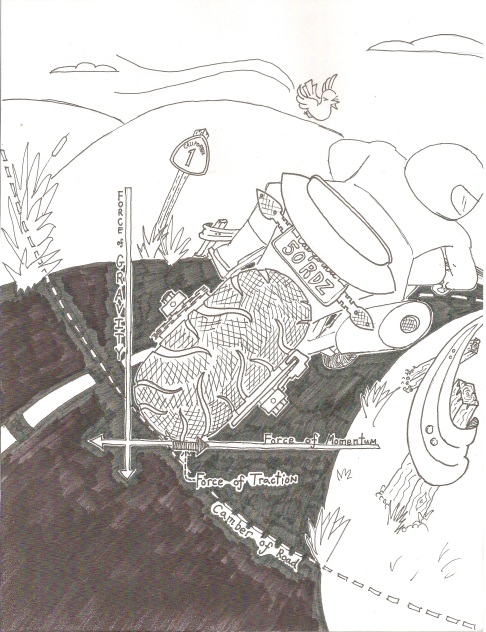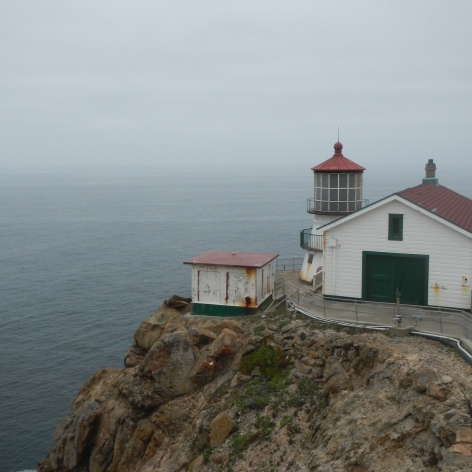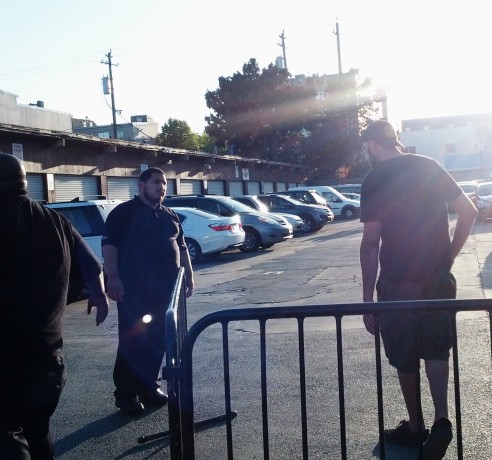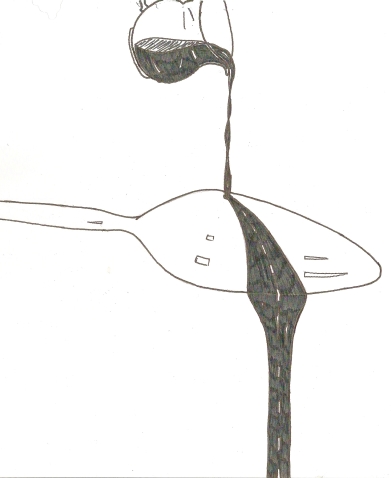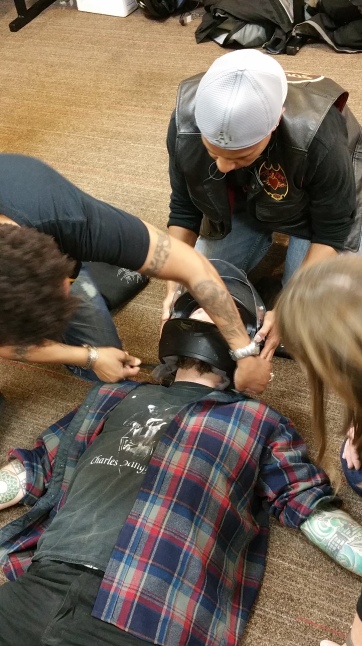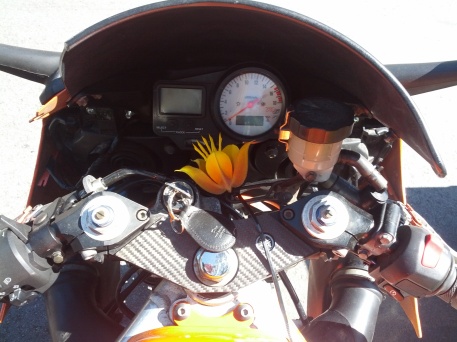
“A completely honest person only tells the truth ninety percent of the time. The other ten percent is spent apologizing.”
It was Mom’s 65th birthday and she was throwing herself a party. A bluegrass/jazz/jug band was to play and everyone was invited. I said I would attend but was scrambling to get things done before heading up to her house in the north bay.
In my rush, I hadn’t really gotten her anything for a gift. There’s a tree in the arboretum that grows a strange flower that looks like a thin hand stretching out of an orange lotus blossom. Was it called a “Buddha’s Hand?” I couldn’t recall. It sounded like a nice present for a mother, and something unique. So I stopped in and plucked one for her and zip-tied it inside the cowling of by sport bike.
This would be a good exercise for me in calming down. The flower would survive regular riding, I was sure. But too much aggressive acceleration or excessive speeding would spell doom for the little bud. Much like the posture-training technique of putting a book on your head, or using a bell to make sure your tai-chi movements are smooth enough, I would know — should the blossom was ripped asunder — if I had relinquished control to my inner speed demon.
And I kept it reasonable on the 101, letting other riders take point as we moved through and around traffic. I took the Napa-Vallejo exit onto 37, then, while turning off at 121 next to Sears Point, I pushed it just a little to get in front of an SUV turning right off of westbound 37. This gave me a clear shot almost all the way to Schellville (a little one-intersection town centered around a Shell gas station that has nothing to do with the name of the town — as far as I’m aware.)
Just before that, though, another SUV in front of me was driving erratically — going the speed limit, then dropping down to 35 mph, then back to 50, a little swerving, slowing down again. Someone was either drunk, lost, on a cell phone, bickering with their partner or all of the above. I made the executive decision to pass them, double yellow be damned.
At the first opportunity, I throttled the sport bike and passed them with little effort. But just as I tucked back into the lane, I noticed a CHP on the opposite side. He was getting out of his truck to give a ticket to a red sedan and, though his frown deepened, he seemed to pretend he hadn’t seen me. There wasn’t much he could do about it anyway. Traffic was steady and he was in the middle of writing a ticket, so a quick u-turn was out of the question. He could have jumped on the radio, but the roads began to branch out from there, so it would be hard to advise other officers.
“Be aware,” he’d say into the radio. “Orange sport bike passing slower traffic; heading north, possibly to Napa, Sonoma or Petaluma.”
There’d be radio silence and then an older patrolman would respond: “Sounds like it’s still Sunday.”
But seriously, I made a point for that to be the most erratic thing I did all day. And I continued to luck out. Traffic was clear and I cruised down nice, open, twisting roads I know like the back of my hand. I got some good cornering practice in, setting a good speed, then leaning, looking and pushing through the turns. I tried to remind myself to be happy and take it easy. It was a nice day, I had clear roads and a well-running rocket. “Isn’t this nice?” I asked myself. But I was still thinking a lot. Going to the old home town always brings up some unpleasant memories.
The pleasant, wine-country suburb we lived in was tranquil and picturesque, but offered little stimulation for someone interested in adventure and wild nights. And Mom and I have had a mixed relationship since my teens — we even had a bad fight in the backyard once, physically struggling for control of a garden hose. Dad dying didn’t make things any easier. She’s a sweet lady that did her best to raise us well but, like many sons, I found her stifling. I remembered the time we were at the supermarket and I grabbed a box of cocoa puffs. “You don’t like those,” she said. I remembered standing there, shocked, thinking, “Jesus lady, you think that’s gonna work? You think I don’t know what the heck these delicious little niblets are? Ok, ok, fine. I’ll put ‘em back.”
And then there was the confusing censorship growing up. I wasn’t allowed to watch cartoons that had guns but I was allowed to shoot 22s at Boy Scout Camp. Mtv was off limits and, any time I went on a date, I was expected to provide a phone number for the girl’s parents. I remember one girl laughing about how her dad was probably passed out drunk anyhow.
So I started doing drugs and lying just to get out and have a good time, taking acid and coke by the time I was twelve years old. Shit, I couldn’t watch any of the stuff on TV that the other guys were talking about. I was really into bikes and snowboarding, but those were seen as dangerous. “Wear a helmet,” was most of what mom had to say about those.
All the warnings that Mom gave about everything added up to a general distrust of authority. If people told you not to do something, it probably meant it was awesome. As you can see from above, I still operate that way. Although I’ve mellowed out, like many bikers, I remain the one that decides whether I’m safe or not. And a lot of forbidden fruits are pretty sweet. Breaking the speed limit? Awesome. Going to the bad parts of town? Awesome. Smoking pot and listening to that “devil’s music” heavy metal? Both awesome. Unprotected sex? Schedule five narcotics? Beer before liquor? Staying out all night? Forgetting a sweater? All awesome.
But it is usually nice to have that sweater. And my mom is a really caring person that I owe a great debt to. She helped get me through college, something I probably wouldn’t have done without her insistence. And she’s a great ear when I’m down or confused, especially about women. She really gets mad when a girl breaks my heart, angry that anyone would hurt her “little baby.” I am truly lucky to have such a loving, concerned mother.
And her friends are very nice people. And so I came for the party, bringing along the “Buddha’s hand” flower for her. I talked with close family friends and we had good conversations about the state of the world; the gentrification in San Francisco; what a nice lady my mom is and how happy she seemed to have everyone there.
And I was questioned about my life by people that remembered me but that I had almost no memory of or interest in speaking to about their boring, cookie-cutter suburban lives in the wine country; sitting around drinking spoiled grape juice in their segregated, cloistered communities of expensive cars and conservative, religious beliefs; saying to each other, “Isn’t this nice?”
Maybe I just envy them. I wish I could ride a desk and go home to my ranch-style stucco home, sipping a rare vintage and catching up on the latest, banal drama on TV, dumbed-down from the controversial book published ten years ago. That would certainly let mom stop worrying about her crazy son. But I can’t. That’s not me. I have an intrinsic need to seek conflict, push the limits, feel the wind. If things are too still, to calm, I get uneasy. If there’s no challenge, I feel like something’s sneaking up behind me. “What’s the catch?”
I really tried though. I tried to be genuine when they asked what I was doing with my life. I started earnestly explaining the motorcycle first-aid course I had taken the day before, describing how to treat blood-loss vs CPR. That turned out to be a pretty good, unintentional way of ending conversations. “Oh, well, uh… that’s nice, uh…let me see where my husband went.” Even when I try to fit in, I find out I’m from a different walk of life.
This is the problem with all our relationships with our parents: we are who we are and we are different. Our parents tried their best to keep us safe but still be ourselves. And we tried our best to please them while pursuing our own interests. Just as they had to set standards for us, we had to test them, had to leave the sweater on purpose, find our own way. Out comes another human instead of a perfect dream. And the humans keep falling in love and trying to keep their perfect little dreams safe.
At least we all keep trying. I know I sound like an ungrateful brat in this blog, but I’m really hoping that this improves my relationship with my mom. A little honesty, not just said in passing while grumpy or annoyed. I’m not trying to hurt anyone. This is just who I am, how I feel. And that can only ever change so much before I’m miserable, lying to myself and others.
So I do my best to be nice. While at the party, I kept looking for pictures of the Buddha’s Hand flower on my smart phone but kept finding pictures of an orchid. Then I thought a moment longer and did a different search. Bingo. “Oh well,” I thought. “Not cut out for this stuff again…”
“Happy Birthday, Mom. I love you,” I said before leaving. “Oh, and it turns out I brought you a Devil’s Hand flower.”
She smiled and hugged me because she’s a really sweet lady.


